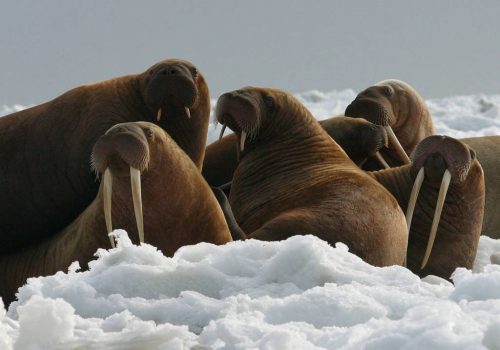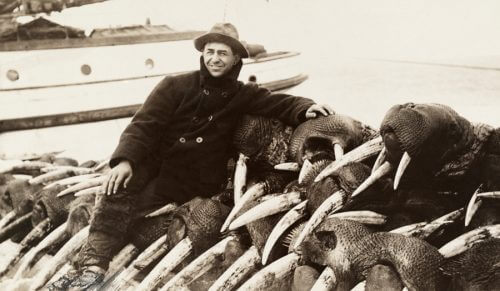The American government decided not to include many animals in its list of protected species. Is this another part of the president's climate change denial?

By Racheli Vox, Angle, Science and Environment News Agency
On blocks of sea ice that float not far from the North Pole are herds of seahorses of the Pacific Walrus type that huddle together in the frozen landscape and are completely unaware of the hard news that has landed on them from the east coast of the distant United States.
The cubs are huge (the weight of the adult animal can reach two tons), brown and mustached, and two long fangs protrude from their mouths. Today, as temperatures rise due to climate change, and the sea ice on which the terns live disappears, the risk to the existence of this arctic animal is increasing. However, the Donald Trump administration recently announced that it would not include the Pacific tern on the US list of endangered species. According to environmental activists, the decision is a death sentence for the animal.
You The decision Published by the American agency responsible for the endangered species list, the Fish and Wildlife Service), in response to a request from the Center for Biological Diversity, a non-profit organization that aims to protect species at risk. Apart from their origin, the service announced that 24 additional species that had been requested to be included in the list would also not be included in it.
In 2011, during the Obama administration, the service declared that the Nibantan was at risk due to climate change and that it was necessary to include it in the list of protected species, but due to the large number of candidates, it postponed making a decision in this case. The current decision regarding the status of the offspring is final.
Need ice to survive
The Pacific terns live in the Bering Sea and the Chukchi Sea, which border Alaska. It is one of the largest species in the pinniped group, which also includes seals and sea lions. They feed on oysters and sometimes also on seals. The Nebatans are hunted by the Alaska Natives and this hunting is their greatest danger. However, an equally serious danger is climate change. The cubs depend on the sea ice for their survival: they need it for the purposes of eating, breeding, nursing and avoiding their predators, the polar bears and the killer whale (orca). "It's actually a marine mammal," says Prof. Uri Shains from the Department of Biology and Environment at Haifa-Oranim University. "The ice surfaces in the North Pole are necessary for the life cycle of the nematodes, and when the ice surfaces are disappearing, then they are in real trouble."
When it comes to the amount of sea ice, which is on a downward trend due to climate change, there are not many reasons for optimism. In 2016, the average sea ice extent was The low secrets Measured an island time. The Arctic is warming rapidly Great פי two than the average warming in the rest of the world, and scientists predict that by the year 2030 No will be In this area there is sea ice in the summer season.
The disappearance of the sea ice often causes the sea ice to come ashore, similar to the phenomenon that occurs in Bear the pole, which also depend on the sea ice. On the ground, it is more difficult for gerbils to obtain food and they are more vulnerable to predators. The gnats are an easily frightened animal, and when a large number of gnats congregate on the ground, the young may to trample About By me the adults in a panic. In addition, many cases have been observed in which due to the melting of the sea ice were separated motherhood their residence, who subsequently drowned or starved to death.

In spite of all this, the Fish and Wildlife Service claims that the population of hatchlings is currently stable, and that it will likely not be at risk in the foreseeable future. According to them, although the Nevatans are experiencing difficulties due to climate change, they may be able to cope and adapt to the loss of sea ice and the changing environment.
Environmental activists do not agree with the claims of the service, and maintain that the rise of the settlers to land is a sign that indicates their difficult situation, and not evidence of adaptation. Also knowing that the service is wrong. "It is quite clear that the ice surfaces are disappearing and it is only a matter of time until the numbers of this species also decrease," he says.
Elephants in the crosshairs
The utility's outrageous decision is far from the first step by the Trump administration that has angered environmental activists. Even before a year had passed since Trump's inauguration as president, he and his administration had time to take many anti-environmental actions, the most prominent of which is of course Retirement from an agreement Paris. Among other things, the Trump administration only recently announced that it would cancel a regulation established during the Obama era, prohibiting the importation of elephant hunting spoils into the US. Following the much criticism he received because of this step, Trump announced that he would delay the decision on the matter. In October, Trump appointed a coal industry lobbyist, who is known to deny the existence of climate change, toVice Yo"ר Agency For protection הסביבה. In March, Trump signed an order that cancels many environmental regulations that were established during the Obama era, and were intended to reduce the damages of the coal-fired power plants that pollute and harm human health and the environment.
As mentioned, following the service's decision, many other species were also not protected, including the Kirtland's snake, the lack-backed woodpeckerB and 14 species of water snails. Three new species were also added to the list: Arizona's Sonoyta mud turtle, a bird from Hawaii called 'I'iwi and a river fish from Louisiana and Mississippi called Percina aurora ((Pearl darter.
Unlike the USA and most countries of the world, where only animals that are on the list of protected species are protected, in Israel the situation is the opposite. "According to Israeli law, all species are protected except for certain species, which can be hunted," explains Shains. "These are several species that are found in very large numbers and species that are considered harmful."
However, the law in Israel does protect the animals - but not the area where they live. In the USA, on the other hand, it is forbidden to damage the habitat of the animals on the list of protected species. "From an ecological point of view, it is much more correct to act in this way", says Shanes. "We are constantly at war, habitats are disappearing - and in the end the species disappear with them. I would like Israel to take the good things in the American law and apply them here."
See more on the subject on the science website:
- Are your findings science or evidence based? You will not receive a budget from the US government
- Trump is performing shock therapy on science and the scientific and environmental agencies
- US withdrawal from the climate agreement - three scenarios
- "We are marching to protest Trump's environmental policy"
- Trump's budget proposal: funding climate change research is a waste of money

2 תגובות
Asaf
According to Wikipedia - Nivatan is a species, and Pacific Nivatan is a subspecies. In the genus Odobenus there is only one species - the progenitor.
Interesting and annoying but:
When translating a piece of news, it is important to be precise in the terms as it is written:
"Pacific Walrus"
From species by division into: families, genera and species,
The Pacific warbler is a species (not a "genus") in the genus Odobenus
It's a shame that the writer/translator is not careful about accuracy...